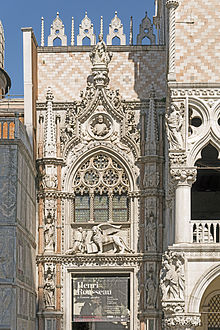Porta della Carta
The Porta della Carta is an entrance portal on the western front of the Doge's Palace in Venice .
Surname
The name Porta della Carta for the gate between the Doge's Palace and St. Mark's Basilica , which leads directly into the inner courtyard, did not appear until the late 15th century. This gate was originally called porta grande , also porta del bando , porta del palazzo or, due to its gilding, porta dorata or porta aurea . Francesco Sansovino referred to it around 1556/57 as l'altra grande , but in his book Venetia città nobilissima et singolare (1581) as porta grande che si chiama hora alla Carta . The origin of the name Porta della Carta cannot be conclusively proven. There are various explanations for this: Because the citizens of Venice, who had no access to the palace, could petition the city government here; because the government decrees were announced here in front of the gate; because of an antiche depositi cartarum behind it, i.e. the State Archives of the Republic of Venice .
construction
The construction of the entrance was decided in the meeting of the Grand Council in 1430 together with the expansion of the west facade of the Doge's Palace . The porta was executed from 1438 to 1443 by the Venetian sculptors and builders Giovanni and his son Bartolomeo Bon .
description
Two polygonal buttresses cut into individual sections, crowned by pinnacles , flank the mighty, right-angled open gate and the window above. In the late 15th century it was decided to have bronze doors made by Alessandro Leopardi for the gate , but this was not realized. Above the window there is a group of figures showing the doge Francesco Foscari kneeling before the lion of St. Mark . It is a modern reconstruction from 1885, as the original was destroyed in the tumult in 1797. Above the large window there is a tondo with a relief of Saint Mark giving blessings, which is held by three angels. Justitia , the allegorical representation of justice , is enthroned on the Wimpergspitze . In the buttress niches at the side of the entrance are Caritas, Prudentia, Temperantia and Fortitudo, the four cardinal virtues .
Hubala recognizes the Porta della Carta as an important monument of the so-called transition style between Venetian late Gothic and early Renaissance. Especially in the sculptures of the virtues one can understand the influence of Tuscan sculptors, who conceived the figures in a more natural and spatial manner.
literature
- Andrea Lermer: The Gothic "Doge's Palace" in Venice. Building history and sculpture program of the Palatium Comunis Veneciarum (= Art Studies. Vol. 121). Deutscher Kunstverlag, Munich 2005, ISBN 3-422-06500-8 , pp. 274-276, (at the same time: Munich, University, dissertation, 2002).
- Giulio Lorenzetti: Venezia e il suo estuario. Guida storico artistica. Presentazione di Nereo Vianello. Ristampa. Erredici, Padau 2002, p. 239, (the original edition appeared in 1926).
- Manfred Wundram (ed.): Reclam's art guide Italy. Volume 2, 1: Erich Hubala : Venice. Brenta villas, Chioggia, Murano, Torcello. Architectural monuments and museums (= Reclams Universal Library . No. 10001–10006). 2nd Edition. Reclam, Stuttgart 1974, ISBN 3-15-010002-X , p. 43.
Individual evidence
- ↑ Andrea Lermer: The Gothic "Doge's Palace" in Venice. Building history and sculpture program of the Palatium Comunis Veneciarum. 2005, p. 276.
Web links
Coordinates: 45 ° 26 ′ 2.9 ″ N , 12 ° 20 ′ 23.5 ″ E
